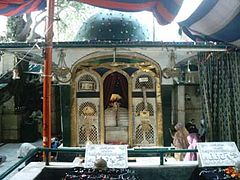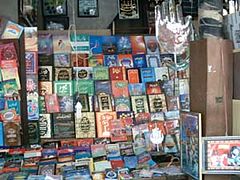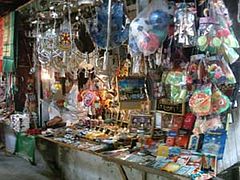Bibi Pak Daman
| Part of a series on |
| Islam |
|---|
 |
|
Bibi Pak Daman (Urdu: بی بی پاکدامن Bībī Pāk Dāman) is the mausoleum of Ruqayyah bint Ali located in Lahore, Punjab, Pakistan.[1] Legend has it that it holds the graves of six ladies from Muhammad's household (Ahl Al-Bayt). Ruqayyah bint Ali ibn Abu Talib was the daughter of Muhammad's cousin and son-in-law Ali ibn Abu Talib.[2] Ruqayah bint Ali was the sister of Al-Abbas ibn Ali and also the wife of Muslim ibn Aqeel[3] (emissary of third Shi'a Imam Husayn ibn Ali to Kufah). Others are said to be Muslim ibn Aqil's sister and daughters. It is said that these ladies came here after the event of the battle of Karbala on the 10th day of the month of Muharram in 61 AH (October 10, AD 680). Bibi Pak Daman, which means the "chaste lady", is the collective name of the six ladies believed to interred at this mausoleum, though it is also (mistakenly) popularly used to refer to the personage of Ruqayyah bint Ali alone.[4] They were among the women who brought Islam to South Asia, preaching and engaging in missionary activity in the environs of Lahore.
Some scholars consider Ruqayah to have been the daughter of Sayid Ahmed Tokhta (12th century). Bibi Paak Daaman is located between Garhi Shahu and Railway Station area. The easiest way to go to Bibi Paak Daaman is from the Empress Road and from there, take the small road opposite Police Lines and then the first left-turn. Recently Government of Pakistan is considering approval of the expansion of the Bibi Pak Daman's shrine.
Urs Sharif/Death Anniversary[]
The shrine is visited by both Shias and Sunnis. In the Islamic month of Jumada al-Thani three days urs of Bibi Pak Daman from 7 to 9 is celebrated. The urs proceedings are mostly a Sunni affair while Shias visit the shrine most commonly during Muharram and Safar. Many Shias also visit during the urs. The street and shrine area remain filled with devotees all the day from all over Pakistan. On the eve of Urs, the shrine is even more crowded. People from across the subcontinent, mainly from Provinces of Punjab and Sindh, come to the shrine to pay their homage and make a wish which they believe more likely would come true. A narrow lane that leads to the shrine has shops on both sides containing Muharram-related items. Imam Ali, Imam Hassan, Imam Hussain and literature on the history of Karbala, Khak-e-Shifa (soil of Karbla) and CDs of Nohas (elegies) are available at the shops.[5][6] A reverence event of urs includes a ritual in which women devotees bring water for ablution of the graves at the shrine of Bibi.[7] The Tourism Development Corporation of Punjab Limited (TDCP), Government of Punjab has placed this shrine in the list of some popular shrines for the tourists.[8]
Gallery[]

The main shrine

The graves

Attendees at Bi Bi Pak Daman

The street leading up to Bi Bi Pak Daman

Religious book shop outside Bi Bi Pak Daman

Shop outside Bi Bi Pak Daman

Brightly lit shop outside Bi Bi Pak Daman

Another brightly lit shop outside Bi Bi Pak Daman
See also[]
- List of mausolea
- Shahr Banu (for similarity to shrine at Lahore and Ray)
References[]
- ^ Syad Muhammad Latif (1957). Lahore: its history, architectural remains and antiquities: with an account of its modern institutions, inhabitants, their trade customs. Syed Muhammad Minhaj-ud-Din.
... Beyond the Government House, at a distance of three hundred yards from the main road, is the tomb of Bibi Pak Daman, or the chaste lady, the most venerated old monument in Lahore and its vicinity. The name of this lady was Ruqayya ...
- ^ Mahallati, Dhabih Allah (1373). Rayahin al-shari'a (Persian Ver.) Vol 04. Tehran: Dar al-Kutub al-Islamiyya. pp. 255–256.
Al-Tabari (1967). Tarikh al-umam wa al-muluk (Arabic Ver.) Vol 04. Beirut: Dar al-Turath. p. 359.
Ibn Jawzi (1992). Al-Muntazam fi tarikh al-ummam wa al-muluk (Arabic Ver.) Vol. 04. Beirut: Dar al-Kutub al-'Ilmiyya. p. 109.
Ibn Sa'd (1990). Al-Tabaqat al-kubra (Arabic Ver.) Vol.3. Beirut: Dar al-Kutub al-'Ilmiyya. p. 14.
"Ruqayya bt. al-Imam 'Ali (a)". WikiShia. Retrieved 14 September 2018. - ^ Zaidi, Noor (July 24, 2014). "A Blessing on Our People": Bibi Pak Daman, Sacred Geography, and the Construction of the Nationalized Sacred". Publication History, University of Pennsylvania. doi:10.1111/muwo.12057.
- ^ Shemeem Burney Abbas (2002). The female voice in Sufi ritual: devotional practices of Pakistan and India. University of Texas Press. ISBN 978-0-292-70515-9.
... Among the women who brought Islam to the subcontinent are the Bibi Pak Daman, or the Pur Women ... Upon arrival in Lahore, they engaged in missionary activity ... Data Ganj Bakhsh Hujwiri ... was a devotee of the shrines of the Bibi Pak Daman ...
- ^ Salahudin Safdar (January 15, 2008). "'Ladies of Purity' remembered". Pakistan Today. Lahore. Retrieved July 30, 2015.
- ^ Ali Usman (April 30, 2012). "Bibi Pak Daman – A place of solace for everyone". Daily Times. Lahore. Archived from the original on April 1, 2016. Retrieved July 30, 2015.
- ^ "Bibi Pak Daman". The National. Pakistan. March 28, 2015. Retrieved July 30, 2015.
- ^ "What to See". Tourism Development Corporation of Punjab. Archived from the original on January 28, 2016. Retrieved July 29, 2015.
External links[]
 Media related to Shrine of Bibi Pak Daman, Lahore at Wikimedia Commons
Media related to Shrine of Bibi Pak Daman, Lahore at Wikimedia Commons- Future Project in Lahore (Pakistan) with a documentary clip
- WikiShia: Ruqayya bt. al-Imam 'Ali (a)
- Shrines in Lahore
- Sufi shrines in Pakistan
- Ziyarat
- Mausoleums in Punjab, Pakistan
- Shrines in Pakistan







